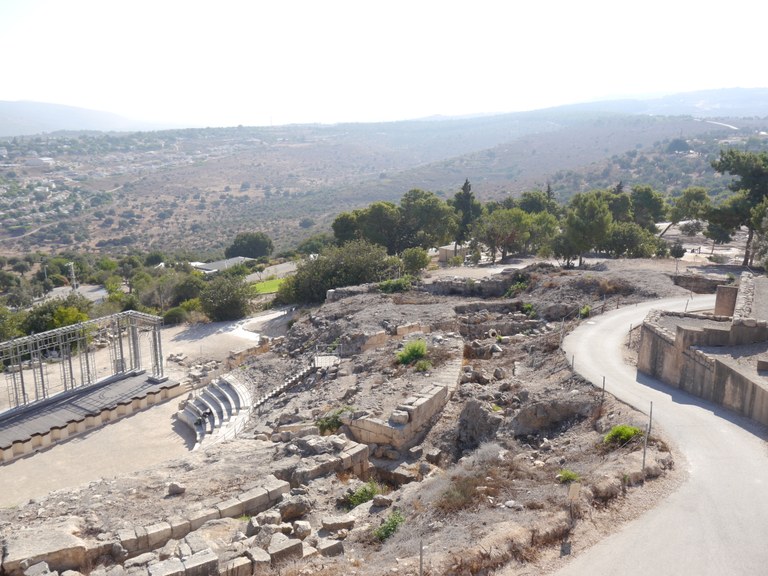Great wealth - including churches - must have characterized the late ancient city of Elusa (Haluza) on the edge of the Negev desert. Written sources only vaguely suggested this, as did the only two buildings known for a long time: the theater and the so-called Eastern Church. Since 2015, however, the Cologne Institute for Classical Archaeology, in cooperation with the Israel Antiquities Authority (IAA) under the direction of Prof. Dr. Michael Heinzelmann and Dr. Tali Erickson-Gini, has been conducting prospections and targeted stratigraphic sondages at Elusa.
The results surprised not only with the high structural quality of the architectural remains, their good state of preservation and a sophisticated urban infrastructure, but also with the large number of churches to be assumed.
Since 2018/19, the Christian Archaeology Department of the University of Bonn has been able to investigate one of these church sites and confirm a three-nave complex with an atrium in the western part of the city. Its dimensions and the large amount of imported Proconnesian marble, numerous architectural fragments as well as stone and glass tesserae show the special effort and high standards of the early Christian community(ies) in Elusa


Within the two campaigns so far, the following research points were the main focus of the work on site:
- A fundamental recording of the so-called Basilica B in the northwest of the inner-city area of Elusa, through concrete excavation and documentation of the church findings, previously documented only by surveys, through new sondages.
- A more exact determination of the building type and reconstruction of the so-called Basilica B, in addition statements about possible further sacral buildings and thus about the sacral topography of the early Byzantine Elusa.
Both previous campaigns took place in cooperation with the Archaeological Institute of the University of Cologne and the Israel Antiquities Authority under the direction of Michael Heinzelmann and Tali Erickson-Gini. The project was funded by the Gerda Henkel Foundation from 2018-2019, and by the DFG from 2022.
The excavations were carried out by students of archaeology at the Rheinische Friedrich-Wilhelms-Universität Bonn under the direction of Prof. Dr. Sabine Schrenk, on site M.A. Florian Michael Jordan acted as excavation director.
Duration: Since 2018
Funding: Gerda Henkel Stiftung (2018-2019); Deutsche Forschungsgemeinschaft: DFG (ab 2022)
Cooperations: Archäologisches Institut der Universität zu Köln; Israel Antiquity Authority (IAA)
Sondages 19 and 20
For the second campaign, again two excavation sections were opened (So 19 and So 20). The larger of the two, Sondage 19, was located in the area of the southeastern apse annex near So 13 of the previous year and covered an area of 10x3 m at the beginning. In contrast, the slightly smaller sondage 20, measuring 4x3 m, was located at the northeast end of the church (near So 14 from 2018). During the campaign, So 19 was initially widened to the northwest by an additional 1.5 m and eventually extended by 1 m, bringing the total dimensions to 4.5 x 11 m.
In both sondages, an approximately one meter thick layer of buried soil was encountered under a thin layer of humus. It consisted mainly of stone material, architectural fragments, a few marble remains, and stone and glass tesserae. It is assumed that this lintel originated from the outer walls and the wall between the side room and the side aisle. Only the synthronon, the semicircular priest's bench, parts of which had already been cut last year, and the NE wall were soon encountered under the humus in So 19.
Exterior walls of the church were documented in both sondages. The NE longitudinal wall of the church had a width of about 82 cm in both sections, the NW transverse wall in So 20 is about 20 cm narrower. Both walls tie into each other. In So 20, the screed of the side aisle (as in So 14 from 2018) was discovered, on which the marble slabs rested. The imprints of the slabs could still be partially reconstructed. Outside the NE wall, part of an annex room was uncovered, the floor of which was covered with large stone slabs. Northwest of the outer wall a very well preserved stone slab floor was encountered. It is assumed that it belonged to an atrium located in front of the church.
In So 19, a second wall was found outside the northeastern longitudinal wall of Basilica B, and beneath a street pavement. Below this, further road layers were preserved, as well as in the foundation area of the basilica's outer wall. These road layers are of great importance for the reconstruction of the basilica: they allow the conclusion that the church was not wider and thus had only three naves. As in last year's So 13, pottery was also recovered from the street layers. However, the dating cannot be given finer than "Byzantine" (4th-7th century AD) due to the lack of diagnostic pieces. In addition, in So 19 other parts of the apse and synthronon discovered last year could be uncovered, so that now the radius of this part of the church can be reconstructed. The central apse had a total width of about 7 m; the stepped priest's bench leaned against it.
As in 2018, the majority of the finds came from the burial layers. In addition to a very high number of architectural fragments (capitals, bases, column drums) made of local sandstone, marble remains of floor slabs and wall cladding were unearthed, as well as possibly the remains of a door panel made of Proconnesian marble. Again, stone and glass tesserae but also other glass fragments such as window glass were found.
The excavation team:
Mathis Laux, Sarah Fahldieck, Ellen Igelmund, Ferdinand Wulfmeier, Florian Jordan und Stefanie Archut